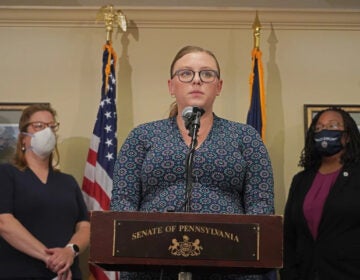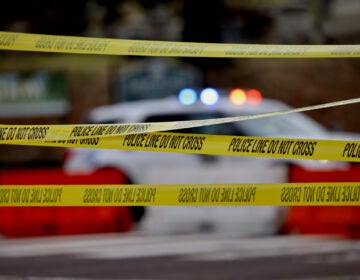81 Pa. county jail suicides in 4 years: A look at how jails report deaths
Numbers from the state Department of Corrections provide context for the breadth of the problem across Pennsylvania. Figures for the most recent year were released in February

In this Tuesday, Oct. 23, 2018 photo, barbed wire lines the top of a wall at the deactivated House of Correction in Philadelphia. (Matt Rourke/AP Photo)
This story originally appeared on PA Post.
—
In Allegheny County, officials might hire an outside consultant to review their policies and procedures for preventing suicide at the local jail.
The move comes after seven suicides in three years at the county jail, the Pittsburgh-Post Gazette reported earlier this month.
Numbers from the state Department of Corrections provide context for the breadth of the problem across Pennsylvania. Figures for the most recent year were released in February.
Over the past four years, county jails reported 81 suicide deaths to the Pennsylvania Department of Corrections. They also reported an additional 123 deaths— most labeled as “natural.”
Here’s a look behind the jails’ reports.
The map
In the map below, yellow dots represent jails that reported no deaths and red dots represent jails that reported at least one.
Click on a dot for information about the number of suicides, other deaths and attempted suicides. You can also see how many inmates were typically in the facility during a given month.
For Philadelphia, separate reports are made for jails. The location of the facilities is approximate. Some small counties do not have jails.
What the jails report
County jails reported the following:
- 2015 — 19 deaths by suicide out of 51 total deaths
- 2016 —24 deaths by suicide out of 49 total deaths
- 2017 — 20 deaths by suicide out of 48 total deaths
- 2018 — 18 deaths by suicide out of 56 total deaths
There were typically more than 30,000 total inmates in county jails across the state each month.
The number of attempted suicides that counties reported increased last year
County jails reported:
- 2015 — 161 attempted suicides
- 2016 — 171 attempted suicides
- 2017 — 165 attempted suicides
- 2018 — 218 attempted suicides
For attempted suicides, the Department of Corrections guidelines say counties should report “only those attempts that require medical treatment beyond immediate first aid or requires a mental health referral or both.”
Over several years, Montgomery County in suburban Philadelphia has ranked high for the number of attempted suicides reported — both in raw numbers and when you adjust for the number of inmates at facilities.
But John Corcoran, a spokesperson for the county, said the county ranks high because staff at the jail “take suicide prevention so seriously.” Staff will send inmates to the medical division and place them on suicide watch if there’s any indication of suicidal thoughts, he said.
Berks County also ranked high for the number of attempted suicides reported. Warden Janine Quigley said there is some subjectivity in these cases and she errs “on the cautionary side for reporting.”
Types of deaths that are reported
There are four categories for counties to report: natural, accidental, by homicide, by suicide.
Claire Shubik-Richards, executive director of the Pennsylvania Prison Society, which advocates for inmates, said her organization also looks into problems that could have led to deaths labeled as natural. Sometimes those deaths could have been prevented with proper medical attention, she said.
Limits to the state data
The information is based on what counties report to the Pennsylvania Department of Corrections. And it’s possible the counties make mistakes.
For instance, PA Post spotted discrepancies between what York County jail officials reported for 2018 and what news accounts described last year.
We reached out to York County, which then reviewed its numbers and corrected them with the state.
“After this review, I understand where the breakdown occurred between our internal reports and the monthly state reports,” York County Prison Warden Clair Doll said in a statement. “… We will adjust our internal reporting and review process moving forward.”
The state data also doesn’t include names and other identifying details for those who died in county jails.
And the way the reporting requirements are written for counties, jails are supposed to describe any “extraordinary occurrence” for inmates, prison employees, contractors, volunteers or visitors to a jail.
That means it’s possible that the deaths included are not just of inmates, said Susan McNaughton, a spokesperson for the Pennsylvania Department of Corrections.
But Shubik-Richards said the data is still useful.
“It allows us to know where to ask questions, and where to dig deeper,” she said. “We can pinpoint who seems to be doing things well, and who seems to be having a lot of preventable tragedies.”

County officials say they take these deaths seriously
John Sallade, managing director of insurance programs for the County Commissioners Association of Pennsylvania, works with most of the county jails in the state to handle death cases and other potential lawsuits.
He thinks counties are always assessing how they respond to suicide risks.
“This is not only a horrible, traumatic experience for the family of someone who commits suicide. This is not something that anybody wants to have happen in their workplace,” Sallade said.
He said, in general, newer facilities see lower suicide rates.
“The older buildings have issues with sight lines, with communications,” he said. “That can be a struggle.”
Suicide rates are generally higher in local jails
That’s what The Marshall Project, a journalism organization focused on criminal justice issues, reported in 2015.
The organization compared the 2013 suicide rate for local jails, which was 46 per 100,000 inmates, to the age-adjusted suicide rate among the general population. That general population rate was 12.6 suicides per 100,000 people in 2013.
County jails are mainly for people who have been charged with a crime and are awaiting trial, or they’ve already been found guilty but have received a relatively short sentence.
Shubik-Richards, with the Pennsylvania Prison Society, pointed to two reasons for the higher suicide rate for people in jail.
One, she said, there’s a higher rate of mental illness for people in custody, generally.
“And … even without mental illness, the outlook on one’s life and one’s future — if you’re confined behind bars and deprived of your liberty — is often pretty bleak,” she said.
News organizations have described issues across the state
Following recent suicides by inmates and appeals by inmate advocates, county officials will issue a request for proposals to hire a consultant to examine Allegheny County Jail suicide prevention policies and practices https://t.co/0K5qkGVMzN @PittsburghPG
— Kate Giammarise (@KateGiammarise) February 8, 2019
In 2017, a lawsuit over the suicide of a Delaware County inmate ended with a $7 million settlement, Philly.com reported. News reports have cited that case when describing efforts by some Delaware County residents to push out the for-profit prison operator who manages the jail there.
Philly.com has also looked at a rise in suicides at state-run prisons, and possible explanations.
Last year, Lebanon County agreed to pay nearly $5 million to the family of a teenager, who died after suffering from heroin withdrawal in jail, The Associated Press reported.
In Bucks County, there were multiple occasions when county officials didn’t release any information about an inmate’s death until media members made inquiries, the Bucks County Courier Times reported earlier this year.
—
PA Post is a digital-first, citizen-focused news organization that connects Pennsylvanians with accountability and deep-dive reporting.
WHYY is your source for fact-based, in-depth journalism and information. As a nonprofit organization, we rely on financial support from readers like you. Please give today.





